Neuroinformatics
The purposes of our research with computational methods are:
- to examine functions of single neurons and their network.
--- Understanding a real brain as "mutual actions" of neural population. - to explain phenomena inside and outside of a single neuron with protein network (Systems Neurobiology)
--- Understanding a real neuron as "mutual actions" of protein population.
Systems Neurobiology
The functions of a neural membrane began to be understood when Hodgkin and Huxley models a membrane with ion channels and explain the phenomena successfully. Similarly, computational study on the protein network inside a cell for further understanding neuron. Our current subject is to simulate a signal transduction of protein cascade in a growth cone and hippocampal synapse.
Properties of a Single Neuron
What signal does a single neuron detect and convey to other neurons? The followings are interesting responses of a single neuron to some characteristic inputs.
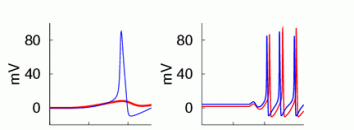

The responses of the neuron to similar stimulus (blue and red) are different in the left column. In the right column, on the other hand, the responses are almost same even though the stimulus are very different in size. These responses are caused by the sensitivity of ion channels to the change and imply that a neuron is not a simple element which integrates input and generates spikes with a fixed threshold. in vivo experiment also reports neural dynamical threshold (Azouz & Gray, 2000).
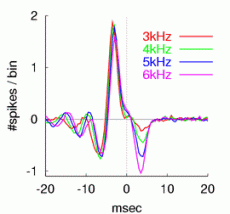
The figure above shows the reverse correlation analysis which is the histogram of synaptic input timings averaged around the time of each output spike (output time is shifted to 0 msec and mean input rate is normalized to 0 spikes/bin). Four types of Poisson rate (3-6kHz) are applied as a time series of synaptic input. This figure suggests that the input fluctuation rather than the input amplitude is important for neuron to fire. Cortical neurons have similar property (Mainen & Sejnowski, 1995).
Using these properties, we proposed the stochastic neuron model with Markov chain as the following figure:
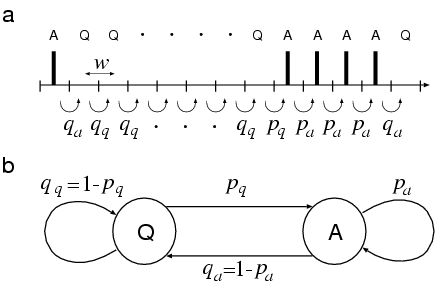
Information Processing of a Single Neuron
Information Processing with Stochastic Resonance
Stochastic resonance (SR) is a phenomena in which some amount of stochastic noise can maximize detectability of a weak signal in a nonlinear system by resonance between the signal and the noise.
It is likely that neurons receive not only signal spikes but also noise spikes.
In such a condition, we calculates the temporal correlations between input spike packets (weak signal) and output spikes. We also examined the dependence of the correlation on a noise intensity (Poisson rate).
Figure A is the temporal correlation between input and output depending on the frequency of excitatory noise spikes (Hodgkin-Huxley model). This shows that the correlation has a peak at an optimal frequency. However, it is doubtful that this result is really caused by SR. It is possible that the temporal pattern of input signal appears just because the mean activity of the neuron is shifted up. Figure B gives the evidence that the result of Figure A is the SR. The mean of input stimulus (conductance) is fixed in Figure B while the mean as well as the variance increases with the input frequency in Figure A. As explained above, Figure B also suggests that the input fluctuation rather than the input mean is important for signal detection. Figure C shows the case of a leaky integrate-and-fire neuron and suggests that the LIF neuron detects signals better with an optimal mean and a smaller variance (the most left point on the pink line). This signal detection is not caused because signal and noise stochastically resonate with each other, but because mean activity is shifted to optimal amplitude.
The functions of a neural membrane began to be understood when Hodgkin and Huxley models a membrane with ion channels and explain the phenomena successfully. Similarly, computational study on the protein network inside a cell for further understanding neuron. Our current subject is to simulate a signal transduction of protein cascade in a growth cone and hippocampal synapse.
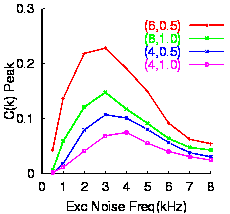 (A)SR by HH. The horizontal axis is the noise intensity and the vertical axis is the temporal correlation.
(A)SR by HH. The horizontal axis is the noise intensity and the vertical axis is the temporal correlation.
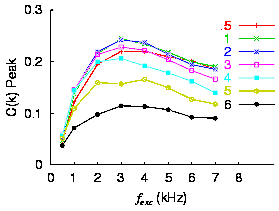 (B) Same as A but mean is fixed.
(B) Same as A but mean is fixed.
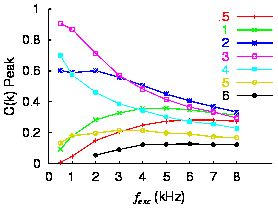 (C) same as B but the neuron model is LIF.
(C) same as B but the neuron model is LIF.